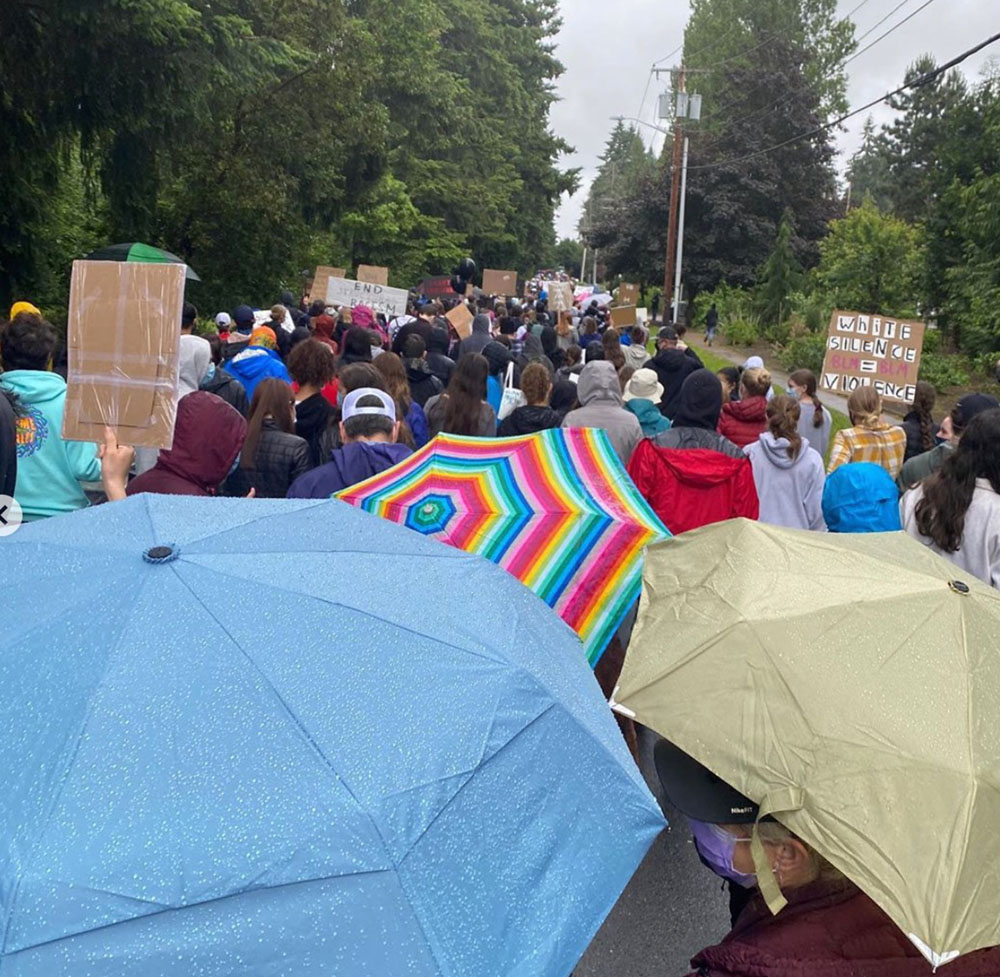
The protests popping up all over the globe is just the drawing back of the ocean. It is just the beginning. We need change, and we need it now.
Abstract
Rebecca de Broglio describes her participation in the Mercer Island, Washington, Black Lives Matter protest. Rebecca offers a personal narrative of how she became an activist, her family’s involvement in protesting against apartheid in South Africa, and how she encountered racism after moving to the United States.
The Black Lives Matter protests led Rebecca to consider the systemic racist history of the United States, as encoded in the popular colonial literature, religion, education, illustrations, justifications for slavery, the Fifteenth Amendment to the United States Constitution, and the Anti-Drug Abuse Act. The author considers how inequity is still present in the United States, passionately advocating for change.
Key words: Black Lives Matter, Mercer Island, racism, anti-racism, protest, climate change, teen activist.


De Broglio, Safia (June 13, 2020). Elizabeth de Broglio, Gabriel de Broglio, and Rebecca de Broglio at the Mercer Island BLM March, Mercer Island, WA. Photograph.
“High school students from Mercer Island have organized a protest: they’re going to be marching from Islander Middle School to Mercerdale Park. Five miles in total, bring food and water.”
The email called me to action. I felt a stirring inside of me. I knew that I had to join the local Black Lives Matter (BLM) protest and fight for what I believed in, no matter what. I started cutting out three cardboard signs, and pulled out my black paint and Sharpies. I am fourteen years old and I can proudly say I am an activist.
In September 2019, I organized a climate change walkout of almost 300 students and faculty at my public middle school. I was shocked that so many people attended, and the experience was exhilarating. I felt like these were the first steps to making change and having an impact on my community. I became an activist and there was no going back.
I was born in Johannesburg, South Africa, and lived there for almost 10 years. Apartheid had already ended, but I heard stories of my family’s role in South African history. My great-uncle, Chris de Broglio, was an anti-apartheid activist. In 1970, he was a key part of the movement that got South Africa kicked out of the Olympics until apartheid ended. Due to this, the South African government hated the de Broglio family. Police would frequently stop by my father’s house, monitoring the entire family, and looking for trouble. My grandmother would remind my father how people would “accidentally” fall out of seven story buildings after having a chat with the police. Our family was not exactly popular because of our views, but we stuck to what we believed because we knew we were right.
My family immigrated to the United States, moving to Orlando, Florida, when I was almost 10 years old. I was shocked to find that, compared to South Africa, racism was more evident in the United States. In South Africa, schools had populations of different races, and children of different races played together. In Florida, schools were either predominantly black or predominantly white. Students seemed to be a lot more aware of their skin color, and would segregate themselves into groups according to race.
I believe all races should be treated equally. Despite the Declaration of Independence (US 1776) stating, “all men are created equal,” that is not what is happening in our country. The tragic death of George Floyd triggered me into action. By attending the protest, I spoke up for what I believed in. Participating in the BLM protest gave me a sense of joy. While I wasn’t in the front leading this protest, I was supporting someone leading a protest – like the people who have supported my climate change protest.
Even when people aren’t in the spotlight leading a protest, being a part of a protest is incredible. Some people can’t even share their opinions with others without a fear of being judged, let alone marching in the streets. If you participate in a protest, I see you as a kind of leader, because you are fighting for what you believe in and demanding change.

De Broglio, Rebecca (June 13, 2020). Children Participating in Black Lives Matter Protest, Mercer Island, WA. Photograph.
On June 13th, almost 1,000 people filed into the vast soccer field of Islander Middle School. Signs were carefully covered in the pouring rain. In preparation for the long walk ahead, snacks and water were offered. In the past, I noticed that most protests were attended by younger people, so I was quite surprised when I found a majority of adults at the Mercer Island BLM protest. Because of the COVID-19 pandemic, almost everyone was wearing masks and gloves; but, no one was six feet apart. At that time, it was impossible to stay separated from my community when the protest relied on everyone standing and kneeling as one united force.

De Broglio, Rebecca (June 13, 2020). People Kneel for Eight Minutes to Honor George Floyd, Mercer Island, WA. Photograph.
I thought, “How did we, as a nation, get here? Why are these protests happening now?” I researched how our founding fathers created a democratic government with love and care, yet encoded slavery, gender inequality, and other stigmas and inequities into our system. These issues still survive and affect my generation. Currently, white women make 75 cents to every dollar that a man makes, and women of color earn even less (Jehadi, 2016).
I do a lot of work around my neighborhood, cleaning houses and babysitting. It shocks me that no matter how hard I work, a male would still make more money than me. In my own school, a kid in my grade walked around with a confederate flag pin on his backpack. He refused to remove it when I asked. Then, I spoke to several teachers and other students about this problem. After being pressured by others, he finally removed it. What saddens me is that not only did the founding fathers fail to create an equal and loving government, but some leaders today fail to correct the mistakes of our past.
Just to quickly clear up any confusion, I think that a racist idea is any idea that suggests something is wrong or right, superior or inferior, better or worse about a specific racial group. An antiracist idea is any idea that suggests that racial groups are equal. Now, I understand you may be thinking, “Huh. I don’t see what the big fuss is about all this! It’s so clear that we must all be anti-racist, and then everything will be fixed.” But, nothing is as simple as that, is it?
Evidence of racism is found throughout the history of the United States. When the first slaves were captured and brought to the colonies, ideas that black people were “inferior” or “savage” were forced down the mouths of the public, to support branding human beings as property. Not only were these ideas promulgated in literature such as Ordering a Familie by William Perkins (Perkins & Pickering, 1609) or The Chronicle of the Discovery and Conquest of Guinea by Gomes Eanes de Zurara (Zurara et al., 1896), these beliefs were actually taught in religious and educational systems.
The first university in America, Harvard University (founded in 1636), taught that Puritans were better than Native Americans, Anglicans, black people, and anyone who wasn’t a Puritan. Similar ideas were encoded in the Anglican religion (Berg, Racism and the Puritan Mind 1975). On top of that, “the devil” that preyed on white Puritans was described as black (Michna, “A Prey to Their Teeth”: Puritan Sermons and Ministerial Writings on Indians During King Philip’s War, 2017). Since the devil was associated with sin and criminality, black people were represented as the face of the devil. Slavery was not only justified, but it was going to be justified for a long time. However, some people didn’t believe in this garbage. The first piece of anti-racist writing was the 1688 Germantown Petition Against Slavery (Carey, Inventing a Culture of Anti-Slavery: Pennsylvanian Quakers and the Germantown Protest of 1688, 2010).

De Broglio, Rebecca (June 13, 2020). Pony Wearing a Sign Reading: “This is NOT black vs. white, it’s EVERYONE vs. RACISM, Black Lives Matter,” Mercer Island, WA. Photograph.
Just as people are fighting today for equity and justice, so were people back then. This fight has been waged over a span of more than 400 years. That’s a pretty long time without equity if you ask me! Even after slaves were freed, they were encouraged to become similar to white people through a racist strategy called uplift suasion (Gaines, Racial Uplift Ideology in the Era of “the Negro Problem”) that implicitly accepts ideas of inferiority by combining anti-racist claims and racist fears in an effort to assert a moralizing middle ground, by placing the weight of combating racism on black shoulders, not white.
Fast forward to when the Fifteenth Amendment was passed in 1870. This amendment made it so that no person could be prohibited from voting due to “race, color, or previous condition of servitude” (Drexler, 2019). While this may seem like an improvement, it actually wasn’t. There were loopholes: voting requirements didn’t have to be equal. Black people were turned away from polls due to supposed fraud, not passing literacy tests, poll taxes, and intimidation. Another tactic used was the “grandfather clause,” telling black people that voting was not available to those whose grandfathers had not voted, which was impossible for most people whose ancestors were slaves (Library of Congress, 2017).
Let’s jump ahead to another, more recent, example of systemic racism, The Anti-Drug Abuse Act (H.R.5484 – 99th Congress (1985-1986): Anti-Drug Abuse Act of 1986). This bill would give a minimum of five years to someone caught with five grams of crack cocaine, which was the amount typically carried by poor people or black people. However, white drug dealers who operated in neighborhoods with fewer police had to be caught with five hundred grams of crack to receive the same sentence. That’s racism. While these examples may be shocking to you, these are just a few grains of sand found in the deadly desert of racism.
People are fed up with being treated like second-class citizens, fed up with being lied to and painted as criminals, lazy, savages, and more. The government may have tried to separate everyone to stop this uprising, but the tsunami was inevitable. The protests popping up all over the globe is just the drawing back of the ocean. It is just the beginning. We need change, and we need it now. Instead of pointing fingers or burying our heads in the sand, let us all join hands in solidarity and stand together as one. We must all be anti-racist.
References
Carey, B. (1970, January 01). Inventing a Culture of Anti-Slavery: Pennsylvanian Quakers and the Germantown Protest of 1688. Retrieved August 21, 2020, from https://link.springer.com/chapter/10.1057/9780230277106_2
De Broglio, Rebecca (2020). Children Participating in Black Lives Matter Protest, Mercer Island, WA. (Originally photographed 2020, June 13).
De Broglio, Rebecca (2020). People Kneel for Eight Minutes to Honor George Floyd, Mercer Island, WA. (Originally photographed 2020, June 13).
De Broglio, Rebecca (2020). Pony Wearing a Sign Reading: “This is NOT black vs. white, it’s EVERYONE vs. RACISM, Black Lives Matter.” Mercer Island, WA. (Originally photographed 2020, June 13).
De Broglio, Rebecca (2020). White Silence Equals Violence, Mercer Island, WA. (Originally photographed 2020, June 13).
De Broglio, Safia (2020). Elizabeth de Broglio, Gabriel de Broglio, and Rebecca de Broglio at the Mercer Island BLM March, Mercer Island, WA. (Originally photographed 2020, June 13).
Gaines, K. (n.d.). “Racial Uplift Ideology in the Era of ‘the Negro Problem.”. Retrieved August 21, 2020, from http://nationalhumanitiescenter.org/tserve/freedom/1865-1917/essays/racialuplift
H.R.5484 – 99th Congress (1985-1986): Anti-Drug Abuse Act of 1986. (1986, October 27). Retrieved August 21, 2020, from https://www.congress.gov/bill/99th-congress/house-bill/5484
Library of Congress (2017). Voting Rights for African Americans. Retrieved August 24, 2020, from https://www.loc.gov/teachers/classroommaterials/presentationsandactivities/presentations/elections/voting-rights-african-americans.html
Michna, G. (2017). ‘A Prey to Their Teeth’: Puritan Sermons and Ministerial Writings on Indians during King Philip’s War. Retrieved August 21, 2020, from https://orc.library.atu.edu/faculty_pub_hist/81
Perkins, W., & Pickering, T. (1609). Christian oeconomie: Or, A short survey of the right manner of erecting and ordering a familie: According to the scriptures. First written in Latine by the author M.W. Perkins, and now set forth in the vulgar tongue, for more common vse and benefit, by Tho. Pickering Bachelar of Diuinitie. At London: Imprinted by Felix Kyngston, and to be sold by Edmund Weauer.
Sehadi, J. (n.d.). For every dollar a man earns, a woman earns. Retrieved August 24, 2020, from https://money.cnn.com/interactive/pf/gender-pay-gap-state-by-state/index.html
Zurara, G. E., Beazley, C. R., & Prestage, E. (1896). The chronicle of the discovery and conquest of Guinea. London: Printed for the Hakluyt Society.
 Rebecca de Broglio is an eighth grader at the Northwest School in Seattle. She has been published in numerous newspapers, including The New York Times, The Seattle Times, and The Mercer Island Reporter as well as two separate poetry books. Rebecca is also a part of the Sunrise Movement at her high school, and has led and participated in multiple protests from climate change and the Black Lives Matter movement. Rebecca has also played multiple lead roles at Youth Theatre Northwest, as well as a lead role in a student short film, “Welcome Home.”
Rebecca de Broglio is an eighth grader at the Northwest School in Seattle. She has been published in numerous newspapers, including The New York Times, The Seattle Times, and The Mercer Island Reporter as well as two separate poetry books. Rebecca is also a part of the Sunrise Movement at her high school, and has led and participated in multiple protests from climate change and the Black Lives Matter movement. Rebecca has also played multiple lead roles at Youth Theatre Northwest, as well as a lead role in a student short film, “Welcome Home.”
